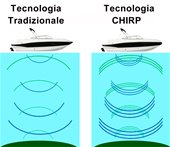Traditional fishfinders are able to send a signal composed of only one frequency to the bottom, while those with CHIRP technology emit a pulse packaged with several frequencies.
Traditional fishfinders with multiple close targets fail to separate them and display them on the screen as a single large target. While CHIRP technology is able to wrap the target with more frequencies, as if the reading were done with multiple probes of different prerogatives. But not only that, each target, depending on the distance and consistency, needs a certain frequency to be better detected and with CHIRP technology, we will have a greater chance of catching it with the right frequency.
These prerogatives allow a better separation of the targets and in general a greater clarity in the reading of the various details of the background. In addition, these features are also maintained at high depths, where the traditional fishfinder tends to lose its orientation and it is therefore possible to say that CHIRP also allows you to read at higher depths.
These characteristics in the fishery are reflected in a better differentiation of the fish and a better separation of them from the structure of the bottom or from the marine vegetation.
CHIRP technology was developed in a military environment in the early 1950s', but it was only in the 2010's that CHIRP technology began to spread to recreational boating.
